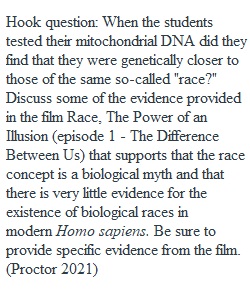


Q Prompts If you are the first person to post in your group, then you should start the discussion using my prompts below: Please re-state the "hook question" from your peer at the beginning of your post and/or the prompt(s) that you are responding to at the beginning of your post. Prompt # 1 Discuss the adaptive purpose of dark melanin in equatorial populations and lighter melanin in populations that originate closer to the poles (low UV exposure). How was folate (a type of vitamin B) involved in Nina Jablonski's "ah-ha moment" when she was researching the evolution of skin color in humans? Prompt # 2 When the students tested their mitochondrial DNA did they find that they were genetically closer to those of the same so-called "race?" Discuss some of the evidence provided in the film Race, The Power of an Illusion (episode 1 - The Difference Between Us) that supports that the race concept is a biological myth and that there very little evidence for the existence of biological races in modern Homo sapiens. Be sure to provide specific evidence from the film. Post You will complete this discussion in a "hook format." This means that you only need to post one time and you need to reply to the student who posted before you. Please end your response with a question that the next student can hook on to. Please re-state the "hook question" from your peer at the beginning of your post and/or the prompt(s) that you are responding to at the beginning of your post. You are welcome to take any stance that you would like in this discussion - all you have to do is be able to back up your argument. It's okay if the conversation naturally moves away from the initial discussion. As long as the subject matter remains anthropological, you can take the conversation wherever you would like it to go. Please directly cite lectures, textbook, article and approved film clips (those found in the direction and/or that week's module) in your response in order to support your argument. Remember to think critically! Examine the the evidence presented, consider the speaker, consider the arguments coming from your professor and classmates and, ultimately, decide for yourself! • Please make sure that your responses are organized into complete sentences. I recommend that you devote at least one full paragraph to answering each discussion prompt. • Your final post should be at least 300 words. • You should exercise college-level writing skills with correct spelling, grammar and punctuation. • You should include reference to at least three academic resources throughout your initial post. • I highly recommend that you first type out your response in a Microsoft Word document and run a spell and grammar check prior to submitting your final post. Reply Posts You will complete this discussion in a "hook format." This means that you only need to post one time and you need to reply to the student who posted before you. Please end your response with a question that the next student can hook on to. Submission Instructions You are welcome to take any stance that you would like in this discussion - all you have to do is be able to back up your argument. It's okay if the conversation naturally moves away from the initial discussion. As long as the subject matter remains anthropological, you can take the conversation wherever you would like it to go. Please directly cite lectures, textbook, article and approved film clips (those found in the direction and/or that week's module) in your response in order to support your argument. Remember to think critically! Examine the the evidence presented, consider the speaker, consider the arguments coming from your professor and classmates and, ultimately, decide for yourself! Rubric This is a graded discussion worth 20 points. Review the discussion rubric by clicking on the Options icon (three vertical dots) located in the upper right of the discussion page. Then, click "Show Rubric" button. Review the assessment criteria and points for this discussion. Feedback Your discussion will be graded within one week of the due date. Please see the gradebook in Canvas for my feedback and suggestions for improvement on future discussions.
View Related Questions